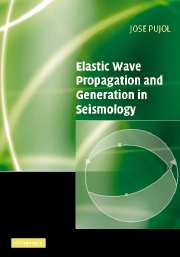Book contents
- Frontmatter
- Contents
- Preface
- Acknowledgements
- 1 Introduction to tensors and dyadics
- 2 Deformation. Strain and rotation tensors
- 3 The stress tensor
- 4 Linear elasticity – the elastic wave equation
- 5 Scalar and elastic waves in unbounded media
- 6 Plane waves in simple models with plane boundaries
- 7 Surface waves in simple models – dispersive waves
- 8 Ray theory
- 9 Seismic point sources in unbounded homogeneous media
- 10 The earthquake source in unbounded media
- 11 Anelastic attenuation
- Hints
- Appendices
- Bibliography
- Index
3 - The stress tensor
Published online by Cambridge University Press: 12 November 2009
- Frontmatter
- Contents
- Preface
- Acknowledgements
- 1 Introduction to tensors and dyadics
- 2 Deformation. Strain and rotation tensors
- 3 The stress tensor
- 4 Linear elasticity – the elastic wave equation
- 5 Scalar and elastic waves in unbounded media
- 6 Plane waves in simple models with plane boundaries
- 7 Surface waves in simple models – dispersive waves
- 8 Ray theory
- 9 Seismic point sources in unbounded homogeneous media
- 10 The earthquake source in unbounded media
- 11 Anelastic attenuation
- Hints
- Appendices
- Bibliography
- Index
Summary
Introduction
The development of the theory of elasticity took about two centuries, beginning with Galileo in the 1600s (e.g., Love, 1927; Timoshenko, 1953). The most difficult problem was to gain an understanding of the forces involved in an elastic body. This problem was addressed by assuming the existence of attractive and repulsive forces between the molecules of a body. The most successful of the theories based on this assumption was that of Navier, who in 1821 presented the equations of motion for an elastic isotropic solid (Hudson, 1980; Timoshenko, 1953). Navier's results were essentially correct, but because of the molecular assumptions made, only one elastic constant was required, as opposed to the two that characterize an isotropic solid (see §4.6). Interestingly, the results based on the simple molecular theory used by the earlier researchers can be obtained by setting the ratio of P-to S-wave velocities equal to √3 in the more general results derived later. Navier's work attracted the attention of the famous mathematician Cauchy, who in 1822 introduced the concept of stress as we know it today. Instead of considering intermolecular forces, Cauchy introduced the idea of pressure on surfaces internal to the body, with the pressure not perpendicular to the surface, as it would be in the case of hydrostatic pressure. This led to the concept of stress, which is much more complicated than that of strain, and which requires additional continuum mechanics concepts for a full study.
- Type
- Chapter
- Information
- Elastic Wave Propagation and Generation in Seismology , pp. 59 - 83Publisher: Cambridge University PressPrint publication year: 2003



